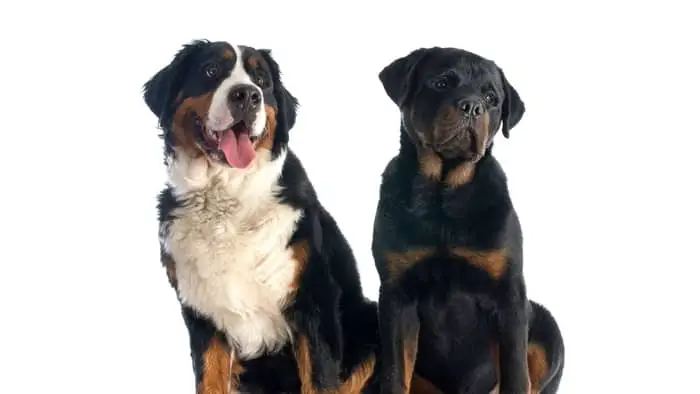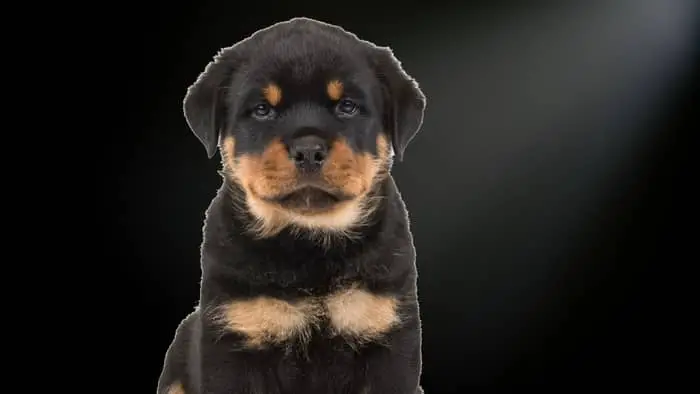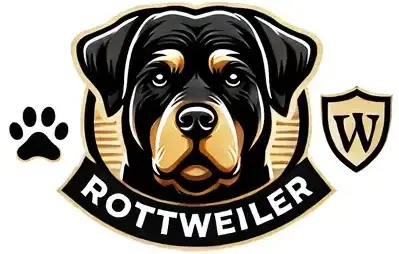Last Updated on September 20, 2021 by
Are the Rottweiler with white chest considered purebred, or are they a crossbreed of two breeds, thus inheriting the white hair trait?
Rottweiler dogs are best known and loved for being protective and loyal to their owners. The Purebred Rottweiler’s have very distinct coat coloring and features that easily identify these dogs.
The Rottweiler’s coat is always straight and shiny, something that attracts many breeders to this dog. They have an all-black colored coat with mahogany or rust-colored spots on all 4 legs, including the inner legs.
Some Rottweilers white spots or patches are on their chest. The American Kennel Club terms this white patch an undesirable trait for Rottweiler’s that you plan to show or breed.
Table of Contents
The History Of The Rottweilers With The White Chest
The white spot in the Rottweilers dates back into the late 1890s to the early 1900s.
The 2 most common molossar dogs in those years were the Bernese mountain dog and the Greater Swiss Mountain Dog.
There were several other molossar dogs, but the two dogs most popular for the white chest were the 2. These 2 dogs originated from Switzerland.
The white hairs on a Rottie’s chest come from the Bernese mountain dog and the Greater Swiss mountain dog mixed with mastiff-type pet dogs to develop the first Rottweiler. These 2 breeds had white chests; so do some modern-day Rottweilers.

Read more about: Dogs Similar To Rottweilers: A Definitive List
Observations From AKC About The Rottweilers With White Markings On The Chest
The AKC insists that the rust or mahogany markings should be less than 10 % of the pet’s coloring. A white marking on any location on the pet is faulted in the show ring. Besides the dog shows where this dog is not accepted fully, it is a perfectly normal Rottweiler.
These white hairs are commonly seen on the chest but can also appear on the face or head. The German canine clubs also disqualifies Rotties with any white markings anywhere on their body.
White markings on your Rottweiler is not a cause for alarm regarding its health. Some pure-blooded Rotties might have white marks on the chest, on the face, paws, or in between the shoulders. It is perfectly normal for the white spots to come to every few generations or so.
In some rare cases, older pets become white, which is a result of ageing. Not that they become an all-white Rottweiler, but it just gets some markings that look more grizzled than pure white.
What Other Colors Are Found In Rottweilers
Rottweilers can be born albino or with a bluish or red color. These rare and uncommon anomalies do not happen often. A blue or red Rottweiler most likely comes from a mix.
A red Rottweiler has the entire physical requirement but is all red or brown instead of the normal black and red pigmentation. A blue Rottweiler is called that when the hairs of the topcoat are lighter in color than the undercoat. This gives the general whitening impact that rinses the whole dark color.
A White Spot Or Just A Few Hairs – Any Difference?
Some Rottweilers have a few white hairs on their chest, which is not considered a white spot. A few white hairs on a puppy’s chest may be replaced with the proper color as it grows and loses the puppy coat.

A Rottweiler with a white spot on the chest doesn’t mean it has some hereditary problem. Some people mistakenly label them as a mixed breed despite the reality that minimal white markings can be typical.
A White spot on the chest of a Rottie does not mean the puppy has inferior bloodlines. Even the most elite bloodlines sometimes display this deep-rooted trait.
A Rottweiler’s undercoat color should not be noticeable to the eye without close assessment or grooming. A well-bred Rottweiler’s coat must lay flat.
If you plan to raise show dogs, stay away from Rottweilers with a white spot or wavy or curly fur.
Does A Rottweiler Produce White Spots On Its Litters?
White spots do not show up in litters. You may only experience 1 puppy out of an entire litter having a white spot from time to time.
The next litter may not have any white spots. Therefore it is wonderful to breed the same dogs again.
However, if the female produces an entire litter of white spots, you need to do more research on your dog’s pedigree to know where the traits are coming from.
Some pedigrees have powerful traits that come out all the time. If you have a male serving several females, and each litter has white spots in more than ½ of the litter, then the trait could be from the male.
If the same females producing puppies are bred to a different male, and no white spots are present, the male is a better match. This means the bloodline is matched properly.
For all your breeds, ensure you match the bloodlines carefully to get a clean breed that can be reared for shows or as family dogs. Clean breeding is the beginning of clean breeds.
Conclusion
A white spot is not a sign of any underlying health issues. In addition, the type or color of the fur is not used to determine the health of your furry friend. Even full-blooded Rottweilers can have white spots.
The white hairs on the chest come from deep-rooted genes. The underlying genes make the Rottweiler what it is today — a stunning pet with outstanding temperaments.
Though AKC does not disqualify a Rottweiler with a white spot on the chest, it is a fault and will likely never be placed in a show.
That said, we don’t have to worry ourselves sick because you have a Rottweiler with a white chest. This dog is perfect and beautiful and will provide you with the same protection and fun as the standard marked ones.
Don’t hold back, have fun with your canine friend who has white markings or any other color since they are as healthy as any other dog.
Have a fun-filled day playing with your Rottie, won’t you?
Read more about: How Much Do Rottweilers Shed? A Very Hairy Guide
